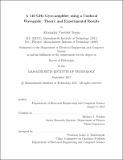A 140 GHz gyro-amplifier using a confocal waveguide : theory and experimental results
Author(s)
Soane, Alexander (Alexander Visotsky)
DownloadFull printable version (16.33Mb)
Alternative title
One hundred and forty gigahertz gyro-amplifier using a confocal waveguide : theory and experimental results
Other Contributors
Massachusetts Institute of Technology. Department of Electrical Engineering and Computer Science.
Advisor
Richard J. Temkin.
Terms of use
Metadata
Show full item recordAbstract
This thesis reports on the theory, design, and experimental investigation of a gyrotron travelling-wave-tube (TWT) amplifier at 140 GHz. The gyro-TWT uses the HE06 mode of a confocal geometry as its operating mode. The linear and nonlinear theory of the confocal waveguide is presented, along with a quasi-optical approach for describing the modes of a confocal waveguide. Both the equations of motion and the mode excitation equation are derived in detail. A beamlet code is introduced as a tool for calculating the linear and nonlinear gain of the azimuthally asymmetric confocal modes that interact with the electron beam with an annular distribution of electron guiding centers. This code has been successfully benchmarked against the code MAGY for azimuthally symmetric cases, and extends the capabilities of nonlinear gyroamplifier theory to configurations that lack azimuthal symmetry. The gyro-TWT experimental setup is presented in detail. Quasi-optical mode converters were designed, fabricated, and tested, ultimately achieving a coupling of -3 dB into the HE06 mode. The source of competing, parasitic oscillations was identified and addressed by the addition of dielectric loading attached to the side of the open geometry of the confocal waveguide. The improvements to the gyro-TWT system allowed for zero-drive stable operation at currents up to 3 A. The design frequency of 140.0 GHz was successfully amplified with 35 dB circuit gain and a -3 dB bandwidth of 1.2 GHz from a 48 kV, 3 A electron beam with a beam pitch factor of 0.64 and a perpendicular velocity spread of 6%. The gyro-TWT produced 550 W at 140.0 GHz under the same operating conditions. During experimental testing, the pulse length used was 2 microseconds. The performance of the confocal gyro-TWT suggests that it may be a candidate for application to Dynamic Nuclear Polarization (DNP) Nuclear Magnetic Resonance (NMR) experiments.
Description
Thesis: Ph. D., Massachusetts Institute of Technology, Department of Electrical Engineering and Computer Science, 2017. This electronic version was submitted by the student author. The certified thesis is available in the Institute Archives and Special Collections. Cataloged from student-submitted PDF version of thesis. Includes bibliographical references (pages 139-147).
Date issued
2017Department
Massachusetts Institute of Technology. Department of Electrical Engineering and Computer SciencePublisher
Massachusetts Institute of Technology
Keywords
Electrical Engineering and Computer Science.